- On Halloween 2003, I picked The Most Horrific Films in
Cinematic History from my perspective as the author/coauthor of 164 books
on the strange, the unknown, and the ghostly, including The Werewolf Book,
Real Ghosts, Restless Spirits, and Haunted Places, The Gale Encyclopedia
of the Unusual and Unexplained (three volumes), and Strange Guests.
-
- The list was comprised of Nosferatu (1922), The Phantom
of the Opera (1925), Dracula (1931), Frankenstein (1931), The Mummy (1932),
Freaks (1932), Island of Lost Souls (1933), The Haunting (1963), The Uninvited
(1944) The Exorcist (1973), Psycho (1960), Invasion of the Body Snatchers
(1956), The Thing (1951), Poltergeist (1982) and The Omen (1976).
-
- As Halloween 2006 approaches, I have chosen The Most
Horrific Films in Cinematic History II.
-
-
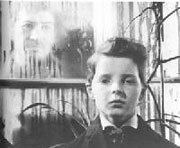 The Innocents (1961)--Henry
James' novel The Turn of the Screw has been adapted many times for motion
pictures and television. Director Jack Clayton's cinematic interpretation
is made particularly effective by his decision to allow the audience to
see the ghosts only through the eyes of the protagonist, the governess
Miss Gliddens (Deborah Kerr), therefore allowing both a paranormal and
a psychological interpretation of the events. As Miss Gliddens catches
a fleeting glimpse of a man or a woman in the shadows of the manor, the
audience comes to accept, as does she, that a servant named Quint and a
former governess, reported by staff members to be dead, are now spirits
negatively affecting the children Flora and Miles. Miss Gliddens resolves
that she must save the children from the two evil spirits that she fears
are slowly possessing them. The film becomes a psychological masterpiece,
dealing with ghosts that may or may not be truly there. The Innocents (1961)--Henry
James' novel The Turn of the Screw has been adapted many times for motion
pictures and television. Director Jack Clayton's cinematic interpretation
is made particularly effective by his decision to allow the audience to
see the ghosts only through the eyes of the protagonist, the governess
Miss Gliddens (Deborah Kerr), therefore allowing both a paranormal and
a psychological interpretation of the events. As Miss Gliddens catches
a fleeting glimpse of a man or a woman in the shadows of the manor, the
audience comes to accept, as does she, that a servant named Quint and a
former governess, reported by staff members to be dead, are now spirits
negatively affecting the children Flora and Miles. Miss Gliddens resolves
that she must save the children from the two evil spirits that she fears
are slowly possessing them. The film becomes a psychological masterpiece,
dealing with ghosts that may or may not be truly there.
-
-
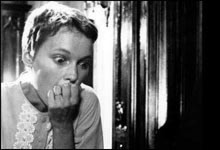 Rosemary's Baby (1968) Beginning
with this film, a new species of cinematic demons arrived to rival Baron
Frankenstein's lumbering monster, Count Dracula's thirst for blood, Wolfman's
remorseful transformation into beast, and invading aliens' search for human
bodies. The monsters who had stalked the collective psyche in the 1930s,
1940s, and 1950s would be replaced by ordinary people, who, in order to
achieve material gain, to avenge themselves on enemies, or to secure the
favors of reluctant lovers had sold their souls to the devil. Rosemary's Baby (1968) Beginning
with this film, a new species of cinematic demons arrived to rival Baron
Frankenstein's lumbering monster, Count Dracula's thirst for blood, Wolfman's
remorseful transformation into beast, and invading aliens' search for human
bodies. The monsters who had stalked the collective psyche in the 1930s,
1940s, and 1950s would be replaced by ordinary people, who, in order to
achieve material gain, to avenge themselves on enemies, or to secure the
favors of reluctant lovers had sold their souls to the devil.
-
- Rosemary (Mia Farrow) and her struggling actor husband
Guy (John Cassavetes) move into an apartment and find themselves becoming
involved with their eccentric neighbors, especially Roman and Minnie Castavet
(Sidney Blackmer and Ruth Gordon) who live next door. Suddenly things begin
to go much better for Guy's career, and Rosemary learns that she is pregnant.
Approaching motherhood should be an occasion of joy, but Rosemary has begun
to suspect that her bizarre neighbors are really satanic cultists who wish
to use her baby in a ritual sacrifice. At the motion picture's climax,
Rosemary learns the horrifying truth: her child is not intended for blood
offering--her child is Satan's very own son, the Antichrist.
-
- The Roman Catholic Legion of Decency gave Rosemary's
Baby a "C" (condemned) rating when it was released in 1968. In
June 2001, the American Film Institute ranked Rosemary's Baby Number Nine
on its list of the top 100 Most Thrilling American Films.
-
- In a cruel irony of life imitating art, Roman Polanski,
the Polish director of the motion picture, was a bemused skeptic who doubted
the possibility that contemporary satanism could exist outside of the pages
of a screenplay or a book. Tragically, on August 8, 1969, Polanski's pregnant
wife Sharon Tate and a number of her friends were viciously murdered in
the director's home by assailants who were obeying the instructions of
Charles Manson, a man who declared himself the Antichrist.
-
-
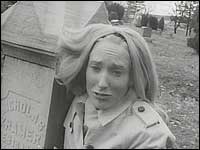 Night of the Living Dead
(1968)-- A staple of horror stories for decades, frightening tales of zombies,
those unfortunate victims enslaved as mindless creatures by evil Voodoo
practitioners, were largely limited to exotic locales. In 1968, George
A. Romero's Night of the Living Dead became the first of an ever-expanding
category of zombie movies in which the masses of the dead--reanimated by
mysterious plagues, mismanaged nuclear explosions, or for no discernible
reason at all--rise everywhere from their graves to seek the flesh of the
living. Night of the Living Dead
(1968)-- A staple of horror stories for decades, frightening tales of zombies,
those unfortunate victims enslaved as mindless creatures by evil Voodoo
practitioners, were largely limited to exotic locales. In 1968, George
A. Romero's Night of the Living Dead became the first of an ever-expanding
category of zombie movies in which the masses of the dead--reanimated by
mysterious plagues, mismanaged nuclear explosions, or for no discernible
reason at all--rise everywhere from their graves to seek the flesh of the
living.
-
- Although I am not a fan of zombie movies, Romero's low-budget
classic does raise some genuine chills and an unyielding sense of dread.
The film focuses on a small group of strangers who barricade themselves
in a farmhouse and attempt to keep a seemingly endless parade of ghouls
from breaking in and feasting on them. The black and white photography
intensifies the ghoulish images adds to the nightmarish quality of the
film.
-
-
 Halloween
(1978)--Rosemary's Baby and The Exorcist (1973) shocked audiences by demonstrating
the grim reality that the Devil is alive and well, but small-town America
could still rationalize that the frightening scenarios depicted in those
films occurred in large cities where one might expect Satan to lurk. John
Carpenter's Halloween shattered the supposed protective barriers that surrounded
small town U.S.A. and graphically depicted a psychopathic boy, who, in
the words of his psychiatrist, was "evil incarnate." Institutionalized
for the murder of his sister, Michael Myers, now 23 years old, escapes
from solitary confinement and returns home to idyllic Haddonfield, Illinois,
to wreak havoc on Halloween. Halloween
(1978)--Rosemary's Baby and The Exorcist (1973) shocked audiences by demonstrating
the grim reality that the Devil is alive and well, but small-town America
could still rationalize that the frightening scenarios depicted in those
films occurred in large cities where one might expect Satan to lurk. John
Carpenter's Halloween shattered the supposed protective barriers that surrounded
small town U.S.A. and graphically depicted a psychopathic boy, who, in
the words of his psychiatrist, was "evil incarnate." Institutionalized
for the murder of his sister, Michael Myers, now 23 years old, escapes
from solitary confinement and returns home to idyllic Haddonfield, Illinois,
to wreak havoc on Halloween.
-
- Horror film buffs are familiar with the story of how
Carpenter screened Halloween for friends and colleagues and was disappointed
to find them rather indifferent to the work. Then Carpenter, also a talented
musician, added that remarkable score that literally pulls the viewer into
the storyline and thereby created a highly successful motion picture, which,
in turn launched a subgenre in horror, the teen slasher flick. While I
am not a fan of slasher films, the first movie in the Halloween series
presents a motion picture of steady, unrelenting terror and suspense, due
in large part to Carpenter's decision never to show his monster in other
than brief shadowy cuts, the brave innocence of the protagonist (Jamie
Lee Curtis in her first film role), the no-nonsense portrayal of the psychiatrist
(Donald Pleasance), and the compelling musical score.
-
-
 The Amityville Horror (1979)--The initial motion picture has spawned a cinematic cottage
industry that has produced numerous sequels of varying quality, but the
original contains a number of scenes that remain logged in the viewer's
memory banks. Horror and paranormal buffs can argue how much is truth and
how much is fiction in the story of a husband and wife (James Brolin, Margot
Kidder) moving into a haunted house, but the general audience is content
to swept away by the suspense and the nightmarish sequence of events captured
by Director Stuart Rosenburg. The Amityville Horror (1979)--The initial motion picture has spawned a cinematic cottage
industry that has produced numerous sequels of varying quality, but the
original contains a number of scenes that remain logged in the viewer's
memory banks. Horror and paranormal buffs can argue how much is truth and
how much is fiction in the story of a husband and wife (James Brolin, Margot
Kidder) moving into a haunted house, but the general audience is content
to swept away by the suspense and the nightmarish sequence of events captured
by Director Stuart Rosenburg.
-
-
 Alien (1979)--The first scene
from this film that will always flash into memory is that of the baby alien
bursting out of William Hurt's stomach. A superb cast featuring Tom Skerritt,
Sigourney Weaver, Harry Dean Stanton, Yaphet Kotto, and Ian Holm transforms
what could have been campy sci-fi into a classic horror film. Alien (1979)--The first scene
from this film that will always flash into memory is that of the baby alien
bursting out of William Hurt's stomach. A superb cast featuring Tom Skerritt,
Sigourney Weaver, Harry Dean Stanton, Yaphet Kotto, and Ian Holm transforms
what could have been campy sci-fi into a classic horror film.
-
- After a brief inspection of a planet from which a suspected
SOS lured them to investigate, the crew of a mining ship in deep space
find themselves desperately struggling for survival against a seemingly
indestructible creature that had been implanted in one of their members.
The monster, designed by H.R. Geiger, presented an alien adversary unlike
any that had previously appeared on the motion picture screen. Director
Ridley Scott heightened suspense by seldom giving viewers more than a glimpse
of the hideous monster, and he reversed movie thriller tradition by giving
audiences its first female action hero in Sigourney Weaver's character
of Ripley.
-
-
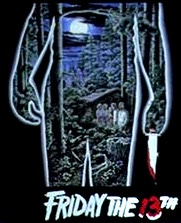 Friday the 13th (1980)--In
my opinion, Halloween may have sown the seeds for the slasher films that
imitated its success, but the character of the unstoppable Jason Voorhees
in his hockey mask makes Friday the l3th the motion picture that truly
caused the slasher flicks to spread like creepy creeping vines throughout
the theaters of the nation. A couple of recent polls named Friday the 13th
as one of the scariest horror movies of all time and Jason
Voorhees as the ninth most popular Hollywood monster, so no true horror
buff can claim expertise without having seen the film. As far as the eleven
sequels that it has spawned, discretion is advised. Friday the 13th (1980)--In
my opinion, Halloween may have sown the seeds for the slasher films that
imitated its success, but the character of the unstoppable Jason Voorhees
in his hockey mask makes Friday the l3th the motion picture that truly
caused the slasher flicks to spread like creepy creeping vines throughout
the theaters of the nation. A couple of recent polls named Friday the 13th
as one of the scariest horror movies of all time and Jason
Voorhees as the ninth most popular Hollywood monster, so no true horror
buff can claim expertise without having seen the film. As far as the eleven
sequels that it has spawned, discretion is advised.
-
- The plot is simple and direct. Camp Crystal, closed for
a number of years due to a series of fatal accidents, including the drowning
of Jason Voorhees, reopens one summer and soon becomes Camp Blood as the
young, attractive councilors are slaughtered one by one. Director Sean
Cunningham's message for teens in this movie would seem to be clear: Have
sex; get horribly murdered. For those who play the "Six Degrees of
Kevin Bacon" game, look for a youthful Bacon as one of the ill-fated
councilors.
-
-
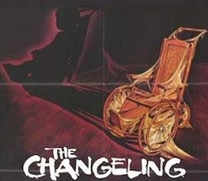 The Changeling (1980)--Some
consider this film the best haunted-house movie since The Haunting (1963).
A recent widower (George C. Scott) moves into an old mansion and discovers
that the creepy place is haunted by the spirit of a murdered child. Scriptwriters
William Gray and Diana Maddox provide a truly eerie ghost story that director
Peter Medak builds skillfully into a superior supernatural tale. The Changeling (1980)--Some
consider this film the best haunted-house movie since The Haunting (1963).
A recent widower (George C. Scott) moves into an old mansion and discovers
that the creepy place is haunted by the spirit of a murdered child. Scriptwriters
William Gray and Diana Maddox provide a truly eerie ghost story that director
Peter Medak builds skillfully into a superior supernatural tale.
-
-
-
-
-
-
-
-
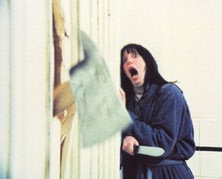 The Shining (1980)-- Iconic
director Stanley Kubrick adapted this film from a Stephen King novel that
I consider the popular fiction writer's best for creating the mood and
the feel of an actual haunting. An isolated mountain hotel has been vacated
by its staff for the winter months and is now inhabited by caretakers John
Torrance (Jack Nicholson), his wife Wendy (Shelley Duval), and their young
son Danny (Danny Lloyd). At first, only Danny, who has what the hotel handyman
Dick Hallorann (Scatman Crothers) calls "the shining," a mediumistic
and telepathic ability to perceive spirit entities and "hear"
others' thoughts, is able to see the ghostly inhabitants of the sprawling
mountain resort. The entities--all murderers or murder victims--become
increasingly menacing as Torrance sinks deeper into depression over his
inability to write productively. Later, as Torrance's nerves grow frayed
by his lack of productivity and the monotony of the family's forced snowbound
isolation, the ghosts appear to work on the writer's weaknesses and bring
him into their evil mindset. The Shining (1980)-- Iconic
director Stanley Kubrick adapted this film from a Stephen King novel that
I consider the popular fiction writer's best for creating the mood and
the feel of an actual haunting. An isolated mountain hotel has been vacated
by its staff for the winter months and is now inhabited by caretakers John
Torrance (Jack Nicholson), his wife Wendy (Shelley Duval), and their young
son Danny (Danny Lloyd). At first, only Danny, who has what the hotel handyman
Dick Hallorann (Scatman Crothers) calls "the shining," a mediumistic
and telepathic ability to perceive spirit entities and "hear"
others' thoughts, is able to see the ghostly inhabitants of the sprawling
mountain resort. The entities--all murderers or murder victims--become
increasingly menacing as Torrance sinks deeper into depression over his
inability to write productively. Later, as Torrance's nerves grow frayed
by his lack of productivity and the monotony of the family's forced snowbound
isolation, the ghosts appear to work on the writer's weaknesses and bring
him into their evil mindset.
-
 Ghost Story (1981)--Four
successful elderly men, members of the Chowder Society, have shared a terrible
secret and suppressed guilt for 50 years. The Peter Straub novel upon which
this film is based is one of my favorite fictional treatments of haunting
phenomena, and director John Irvin does a good job of translating a multigenerational
ghost story from the printed page to the motion picture medium. A superb
cast is used to great advantage in revealing the gruesome secret that has
haunted the memories and dreams of four men (Fred Astaire, Melvyn Douglas,
Douglas Fairbanks, Jr., and John Houseman) and certain unfortunate members
of their families for five decades. The fascinating, seductive entity in
the story is presented as a multidimensional presence, sometimes very physical,
sometimes ethereal--and always something other than it may appear. Ghost Story (1981)--Four
successful elderly men, members of the Chowder Society, have shared a terrible
secret and suppressed guilt for 50 years. The Peter Straub novel upon which
this film is based is one of my favorite fictional treatments of haunting
phenomena, and director John Irvin does a good job of translating a multigenerational
ghost story from the printed page to the motion picture medium. A superb
cast is used to great advantage in revealing the gruesome secret that has
haunted the memories and dreams of four men (Fred Astaire, Melvyn Douglas,
Douglas Fairbanks, Jr., and John Houseman) and certain unfortunate members
of their families for five decades. The fascinating, seductive entity in
the story is presented as a multidimensional presence, sometimes very physical,
sometimes ethereal--and always something other than it may appear.
-
-
-
-
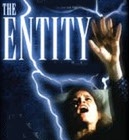 The Entity (1983)-- Many
will find this motion picture, based on the actual case history of a malicious
entity that stubbornly molests a widowed mother (Barbara Hershey), to be
too far-out to be believable. The fact that Sherry and I know the real-life
paranormal investigators involved in this story makes the film all the
more frightening to us. Frank de Felitta respectfully adapts the events
of the Los Angeles haunting/ possession, and Director Sidney J. Furie maintains
a suspenseful atmosphere throughout the unfolding of the story of a real-life
incubus. The Entity (1983)-- Many
will find this motion picture, based on the actual case history of a malicious
entity that stubbornly molests a widowed mother (Barbara Hershey), to be
too far-out to be believable. The fact that Sherry and I know the real-life
paranormal investigators involved in this story makes the film all the
more frightening to us. Frank de Felitta respectfully adapts the events
of the Los Angeles haunting/ possession, and Director Sidney J. Furie maintains
a suspenseful atmosphere throughout the unfolding of the story of a real-life
incubus.
-
-
-
-
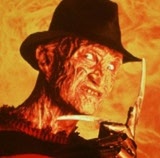 Nightmare on Elm Street (1984)--A
September 2006 poll of adult moviegoers declared Nightmare on Elm Street
as the scariest movie of all time. In an earlier poll, Freddy Kruger, the
slayer of teenagers with his razor-sharp claws, was named the second most
frightening Hollywood monster. Interestingly, just as Boris Karloff, the
original impersonator of Frankenstein's monster--voted most frightening
monster Number Three-- was in real-life a cultured gentleman, Richard Englund,
minus his Freddy make-up, appears incapable of frightening anyone. Nightmare on Elm Street (1984)--A
September 2006 poll of adult moviegoers declared Nightmare on Elm Street
as the scariest movie of all time. In an earlier poll, Freddy Kruger, the
slayer of teenagers with his razor-sharp claws, was named the second most
frightening Hollywood monster. Interestingly, just as Boris Karloff, the
original impersonator of Frankenstein's monster--voted most frightening
monster Number Three-- was in real-life a cultured gentleman, Richard Englund,
minus his Freddy make-up, appears incapable of frightening anyone.
-
- Wes Craven, the director, began his long cinematic horror
career with this film, which depicts the spirit of a child molester-murderer,
who was lynched by a mob of angry parents and returns to avenge himself
on the children of those who killed him. The unique gimmick of the film
was that Freddy could only attack his victims while they were sleeping
and dreaming--a ghastly nightmare literally come true. Heather Langenkamp
is excellent as a teen trying to stay awake to save her life and, in turn,
warn her friends to resist death by slumber. Her boyfriend, played by a
very young Johnny Depp, almost makes it to the end, but he is, alas, horribly
sucked into a mattress and transformed into a gusher of blood.
-
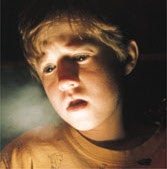 The Sixth Sense (1999)--The
tearful complaint of young Cole Sear (Haley Joel Osment) to child psychologist
Malcolm Crowe (Bruce Willis) that he can see dead people became one of
the most familiar quotes of 1999. M. Night Shyamalan won the Academy Award
for Best Original Screenplay and was nominated as Best Director for this
film, ranked as Number 14 on the list of the top-grossing movies of all
time. Because the audience is able to see the spirits of the dead along
with Cole, the ghosts are presented as solid, physical beings, rather than
wispy, ethereal images. The Sixth Sense carried a shock of recognition
for many psychically sensitive individuals who said that they could very
much identify with the character of Cole, awakening the reality of his
paranormal abilities as a child. The film has a twist ending that brought
many audiences back for a second viewing. The Sixth Sense (1999)--The
tearful complaint of young Cole Sear (Haley Joel Osment) to child psychologist
Malcolm Crowe (Bruce Willis) that he can see dead people became one of
the most familiar quotes of 1999. M. Night Shyamalan won the Academy Award
for Best Original Screenplay and was nominated as Best Director for this
film, ranked as Number 14 on the list of the top-grossing movies of all
time. Because the audience is able to see the spirits of the dead along
with Cole, the ghosts are presented as solid, physical beings, rather than
wispy, ethereal images. The Sixth Sense carried a shock of recognition
for many psychically sensitive individuals who said that they could very
much identify with the character of Cole, awakening the reality of his
paranormal abilities as a child. The film has a twist ending that brought
many audiences back for a second viewing.
-
-
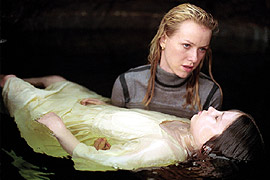 The Ring (2002)--Moviegoers
recently rated The Ring in the top six scariest movies of all time. However,
it must be made clear that the film is neither about Hobbits nor a cinematic
version of Richard Wagner's famous operatic cycle. According to a kind
of underground urban legend, anyone who views a mysterious videotape will
receive a telephone call upon completion of the tape. A voice will whisper,
"Seven days," and, according to the legend, the viewers will
die within a week. As the opening scene graphically shows us, the legend
is true. As preposterous as this sounds to rational investigators of the
bizarre deaths, a journalist (Naomi Watts) begins to take it seriously,
especially when her niece becomes one of the deadly tapes' victims. The
Ring is also available in its original Japanese version, Ringu. I favor
Gore Verbinski's American version, but the horror buff will be likely to
view both films. The Ring (2002)--Moviegoers
recently rated The Ring in the top six scariest movies of all time. However,
it must be made clear that the film is neither about Hobbits nor a cinematic
version of Richard Wagner's famous operatic cycle. According to a kind
of underground urban legend, anyone who views a mysterious videotape will
receive a telephone call upon completion of the tape. A voice will whisper,
"Seven days," and, according to the legend, the viewers will
die within a week. As the opening scene graphically shows us, the legend
is true. As preposterous as this sounds to rational investigators of the
bizarre deaths, a journalist (Naomi Watts) begins to take it seriously,
especially when her niece becomes one of the deadly tapes' victims. The
Ring is also available in its original Japanese version, Ringu. I favor
Gore Verbinski's American version, but the horror buff will be likely to
view both films.
-
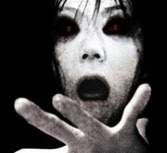 The Grudge (2004)--Takashi
Shimizu was given the opportunity of directing The Grudge and the original
Japanese film Ju-On (2003) on which it is based. The American treatment
with Sarah Michelle Geller is very good, but I urge true aficionados of
horror films to view Ju-On. The Grudge (2004)--Takashi
Shimizu was given the opportunity of directing The Grudge and the original
Japanese film Ju-On (2003) on which it is based. The American treatment
with Sarah Michelle Geller is very good, but I urge true aficionados of
horror films to view Ju-On.
-
- Ju-On will probably seem episodic to most American viewers,
who prefer an understandable cause and effect to their tales of hauntings
and vengeful spirits. In viewing Ju-On, questions may persist as to why
this or that character incurred the wrath of the vengeful spirit that seems
to be able to strike anywhere. In Japanese culture, everything has a spirit,
and the spirits of those who have suffered violent deaths just keep on
continuing the horror that they have experienced. In the Japanese haunting
tradition, spirits are not limited to a particular location. They can pursue
and inflict pain and horror on all those who have become even briefly associated
with the original cursed location. In The Grudge, Takashi Shimizu skillfully
creates viewpoint characters and a plotline for American audiences that
manage to transcend cultural variations and still provide plenty of chilling
moments.
-
- ######
|